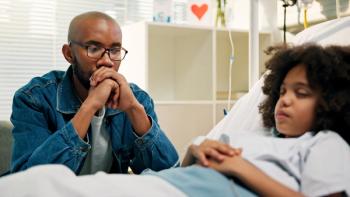
Talking About the Cost of Cancer Care With Patients
During a session at the 2018 ASCO Annual Meeting, June 1-5, in Chicago, Illinois, Nipp and fellow panelists Ellen Miller Sonet, MBA, JD, chief strategy and policy officer, CancerCare, and Gery P. Guy Jr, PhD, MPH, of the Centers for Disease Control and Prevention, discussed the financial burdens of cancer diagnosis and treatment, the barriers facing clinicians and patients in discussing these financial burdens, and solutions that can be implemented to alleviate the burden.
Cancer drugs are becoming increasingly more effective and more tolerable for patients, and they are helping people live longer. That’s the good news. But it means patients are taking these drugs for longer periods of time. The bad news is, prolonged use leads to increased financial burden. Patients with cancer have health costs that are significantly higher than others.
According to Ryan Nipp, MD, MPH, Massachusetts General Hospital Cancer Center, patients with cancer experience financial burdens related to the disease and its treatment across all insurance types at higher rates than those with other chronic conditions and those with no chronic conditions.
During a session at the 2018 ASCO Annual Meeting, June 1-5, in Chicago, Illinois, Nipp and fellow panelists Ellen Miller Sonet, MBA, JD, chief strategy and policy officer, CancerCare, and Gery P. Guy Jr, PhD, MPH, of the Centers for Disease Control and Prevention, discussed the financial burdens of cancer diagnosis and treatment, the barriers facing clinicians and patients in discussing these financial burdens, and solutions that can be implemented to alleviate the burden.
Nipp said that 43% of privately insured patients with cancer spend over 20% of their income on health-related spending, compared with 29.8% of those with another chronic condition and 16.4% of those with no chronic condition. For those with public insurance, 24% of patients with cancer spend over 20% of their income on health-related spending, compared with 18.7% and 5.8%, respectively.
In addition to out-of-pocket costs, such as co-payments, deductibles, and prescriptions, patients with cancer often experience indirect financial issues during cancer treatment, including:
- Employment issues: missed work, disability, job lock.
- Lifestyle factors: children’s education, mortgage/rent, basic living expenses.
- Concurrent issues: psychological distress, fear of the unknown, symptom burden.
“Increasingly, efforts are needed to foster appropriate patient—clinician communication about the cost of cancer care,” said Nipp. “Discussions between patients and clinicians about the costs of cancer care have the potential to improve care delivery and outcomes for patients by fostering informed decision making.”
In an interview with Oncology Nursing News®, Sonet said that these conversations are not only essential to the clinician-patient relationship, but are a hallmark of quality cancer care. “Both ASCO and the National Academy of Medicine have declared that dealing with the finances associated with cancer treatment are essential to the physician-patient relationship and are in fact part of what constitutes high quality cancer care,” she said. “The financial hardships that are posed by cancer cause enormous distress to patients. And its distress associated with finances, but it also really goes to issues around self-esteem, family relationships, sense of control over one’s life, the worries that come from having these enormous medical debts can really overwhelm people. It’s so intrinsic to the physician-patient relationship and the outcomes of their treatment that it really needs to be part of the discussion.”
However, there are numerous barriers facing both clinicians and patients, Nipp explained during the panel discussion. For clinicians, barriers include lack of knowledge about costs incurred by patients, potentially time-consuming discussions, concerns that cost information may encourage patients to forgo care, and concerns that cost discussions may jeopardize the patient—clinician relationship.
For patients, many feel unsure of the appropriateness of discussing costs with their clinician team and embarrassed or self-conscious to raise the issue; they also may have a desire to respect their clinician’s time, are not sure their clinicians would have a solution for the concern, or may prioritize other concerns during a time-limited visit.
Sonet, MBA, JD, followed up Nipp by asking the audience, “Have you ever made a major purchase without knowing the price, be it a car, camera, or computer? Because that’s what cancer patients do. They agree to a cancer treatment plan, and they don’t know what it will cost them.”
Until there are some policy solutions, it’s the problem of the patient and physician relationship, she said. She outlined different solutions that can be implemented to alleviate the burden facing these patients.
First, clinicians should determine who within their office will address the issues with patients. “I think that, very often, the physician thinks the nurse is doing it, the nurse thinks the office manager is doing it, and sometimes nobody’s doing it,” she said.
Other strategies highlighted by Sonet included ensuring patients know the major costs prior to treatment, considering lower-priced options and alternate dosing schedules, asking patients to discuss if treatment is too great a financial burden, and referring to financial and psychosocial counseling.
She also outlined resources available to patients, such as co-pay and patient assistance funds, hospital charity care, patient advocacy organizations, voluntary and faith-based resources within communities, and financial planning and insurance navigation.
CancerCare offers “A Helping Hand,” an online resource guide about financial assistance. There is a searchable database where patients can input a diagnosis and zip code and be presented with different resources available to them.
She also encouraged the use of patient portals for education and links. A patient will feel comfort knowing that if they’re up in the middle of the night worrying about something, they can go online to the website and learn about what's troubling them, she explained.
“Patients’ learning styles may vary. Some people are visual learners, and some patients like to hear information. They will forget most of what their clinician tells them, because they’re anxious, and they’re upset, and they don’t really understand a lot of the information that’s being communicated,” Sonet said. “So, recognize that lots of different media can be very helpful.”
A version of this article was originally published by
Newsletter
Knowledge is power. Don’t miss the most recent breakthroughs in cancer care.
















































































